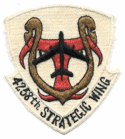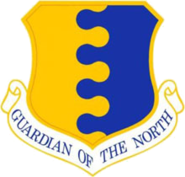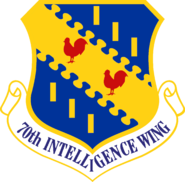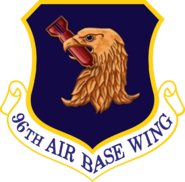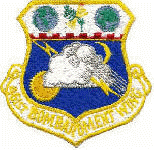| U-Tapao Royal Thai Navy Base
| |
|---|---|
| Part of Royal Thai Navy (RTN) | |
| Coordinates | 12°40′47″N 101°00′18″E / 12.67972°N 101.005°E |
| Type | Naval Air Base |
| Site information | |
| Condition | Military Naval Air Base |
| Site history | |
| Battles/wars |
Vietnam War |
| Airfield information | |||
|---|---|---|---|
| IATA: none – ICAO: none | |||
| Summary | |||
| Elevation AMSL | 42 ft / 13 m | ||
| Coordinates | 12°40′47″N 101°00′18″E / 12.67972°N 101.005°ECoordinates: 12°40′47″N 101°00′18″E / 12.67972°N 101.005°E | ||
| Map | |||
| Location of Udorn Royal Thai Air Force Base | |||
| Runways | |||
| Direction | Length | Surface | |
| ft | m | ||
| 18/36 | 11,500 | 3,505 | Asphalt |
| Source: DAFIF[1][2] | |||
- For the civil use of the facility see U-Tapao International Airport
U-Tapao Royal Thai Navy Airfield is a military airfield of the Royal Thai Navy located approximately 90 miles (140 km) southeast of Bangkok, near Sattahip on the Gulf of Siam. It is serves as the home of the Royal Thai Navy First Air Wing.
Name[]
U-Tapao (Thai language: อู่ตะเภา) is a compound of อู่ cradle and ตะเภา trade winds, and derives from the site having once been a shipyard for construction of ruea-tapao (เรือตะเภา), a type of argosy resembling a Qing Dynasty junk.
Units[]
U-Tapao is the main flying base for the Royal Thai Navy. Squadrons based there include:
- No 101 Squadron flying Dornier DO-228-212 (7 aircraft)
- No 102 Squadron flying Lockheed P-3T/UP-3T (3 aircraft) and Fokker F-27-200ME aircraft (a total of 3, at least one of which is in store)
- No 103 Squadron flying Cessna 337 H-SP (10 aircraft, some may be stored)
- No 201 Squadron flying Canadair CL-215 (1 aircraft), GAF Nomad N-24A (3 aircraft, a fourth aircraft is in store) and Fokker F-27-400M (2 aircraft)
- No 202 Squadron flying Bell 212 helicopters (approximately 6)
- No 203 Squadron flying Bell 214SP helicopters (recently grounded after a fatal crash killing 9 crewmembers on 23 March 2007), Sikorsky S-76B (6 helicopters) and Super Lynx Mk.110 (2 helicopters)
- No 302 Squadron flying Sikorsky S-70B Seahawk anti-submarine helicopters (6 in service)
Two squadrons are dormant
- No 104 Squadron which flew 14 A-7E and 4 TA-7C Corsair strike aircraft
- No 301 Squadron which flew AV-8S and TAV-8S (2 aircraft)
Current uses[]
For several years, beginning in 1981, U-Tapao has hosted parts of Operation Cobra Gold – the largest U.S. military peacetime exercise in the Pacific – jointly involving U.S., Singaporean, and Thai forces, and designed to build ties between the nations and promote interoperability between their military components.
Thailand is an important element in the Pentagon's new strategy of "forward positioning". Despite Thailand's neutrality on the 2003 invasion of Iraq, the Thai government allowed U-Tapao to be used by American warplanes flying into combat in Iraq, as it had earlier done during the war in Afghanistan. In addition, U-Tapao may be where Al Qaeda operative Abu Zubaydah was interrogated, according to some retired American intelligence officials.[3]
A multinational force headquarters was established at U-Tapao to coordinate humanitarian aid for the Sumatran Tsunami of 26 December 2004.
On 7 May 2008, in the aftermath of Cyclone Nargis, Thai C-130 transports were permitted to land at Yangon International Airport in Burma, carrying drinking water and construction material.[4] From 12 to 20 May, USAID and the U.S. Department of Defense (DOD) coordinated the delivery of nearly $1.2 million of U.S. relief commodities to Yangon on 36 DOD C-130 flights, with supplies sufficient to provide assistance to more than 113,000 beneficiaries. The DOD efforts were under the direction of Joint Task Force Caring Response.[5]
As of 26 June 2008, United States assistance directed by the USAID DART (Disaster Assistance Response Team) stationed in Thailand, had totaled $41,169,769.[6] Units involved were the 36th Airlift Squadron (36 AS) of the 374th Airlift Wing (374 AW) from Yokota Air Base, Japan, flying C-130H Hercules; and Marine Aerial Refueler Transport Squadron 152 (VMGR-152) from Marine Corps Air Station Futenma, Okinawa, Japan, flying the Lockheed Martin KC-130R and the newer KC-130J.
In 2012, a proposal for the United States National Aeronautics and Space Administration (NASA) to use the military capacities to support weather research was canceled.[7]
American use of U-Tapao during the Vietnam War[]
Prior to 1965, U-Tapao was a small Royal Thai Navy airfield. At Don Muang Air Base near Bangkok the USAF had stationed KC-135 air refueling tankers from Strategic Air Command (SAC) for refueling tactical combat aircraft over the skies of Indochina. Although Thailand was an active participant in the war, with a token ground force deployed to the Republic of Vietnam and a more substantial involvement in Laos, the visibility of the large USAF Boeing tankers in its capital was causing political embarrassment to the Thai government.
In June 1965, The B-52F was first used in the Vietnam War. B-52F aircraft taken from the 7th and 320th Bomb Wings were sent to bomb suspected Viet Cong enclaves in South Vietnam. The B-52Fs were stationed at Andersen AFB on Guam, the operation being supported by KC-135As stationed at Kadena AB on Okinawa. By November 1965, the B-52s were able to support the 1st Air Cavalry Division in mopping up operations near Pleiku.
The Seventh Air Force (PACAF) wanted to have additional B-52s missions flown into the war zone; however, the B-52 missions from Andersen, as well as from Kadena AB, Okinawa, required long mission times and air refueling. Concerns about base security with having the aircraft based in South Vietnam led to the change of mission at Tuy Hoa Air Base from that of basing B-52s there to one of a tactical air base. It was decided that, as the base at U-Tapao was being established as a KC-135 tanker base to move them out of Don Muang, to also base the B-52s there where they could fly unrefuelled throughout both North and South Vietnam.
The construction of U-Tapao Royal Thai Navy Airfield began in October 1965 and was completed slightly more than two years later. The 11,000-foot runway was opened on 6 July 1966 and the first aircraft to land was a Royal Thai Air Force HH-16 Helicopter, then a USAF C-130 Hercules cargo aircraft.
With the completion of U-Tapao, most American forces were transferred from Don Muang, and U-Tapao RTNAF became a front-line facility of the United States Air Force in Thailand during the Vietnam War from 1966 through 1975.
The USAF forces at U-Tapao were under the command of the United States Strategic Air Command (SAC). The APO for U-Tapao was APO San Francisco, 96330
4258th Strategic Wing[]
The 4258th Strategic Wing (SAC) was activated in June 1966 at U-Tapao under the 3rd Air Division, Andersen AFB, Guam. The wing was charged with the responsibility of supporting refueling requirements of USAF fighter aircraft in Southeast Asia, plus conducting bombing missions on a daily basis.
Steadily progressing and adding to the mission, U-Tapao welcomed its first complement of KC-135 tankers in August 1966. By September, the base was supporting 15 tankers. From 1966 to 1970, 4258th wing tankers flew over 50,000 sorties from U-Tapao.
On 10 April 1967, three B-52 bombers landed at U-Tapao following a bombing mission over Vietnam. The very next day, B-52 operations were initiated at U-Tapao. Under the operational nickname “Arc Light”, wing bombers flew over 35,000 strikes against the communist enemy from 1967 to 1970.
B-52 Missions from U-Tapao[]
Although the B-52F carried out the first B-52 missions in Southeast Asia, less than 6 months later, the Air Force decided to convert most of its B-52Ds to conventional warfare capability for service in Southeast Asia. Modifications were needed to give the B-52D the ability to carry a significantly larger load of conventional bombs, which led to the Big Belly project that was begun in December 1965. The project increased the internal bomb capacity from just 27 weapons to a maximum of 84 500-lb Mk 82 or 42 750 lb M117 conventional bombs. This was done by careful rearrangement of internal equipment, and did not change the outside of the aircraft. In addition, a further 24 bombs of either type could be carried on modified underwing bomb racks (originally designed for the carrying of AGM-28 Hound Dog cruise missiles and fitted with I-beam rack adapters and a pair of multiple ejection racks), bringing the maximum payload to 60,000 pounds (27,000 kg) of bombs, about 22,000 pounds (10,000 kg) more than the capacity of the B-52F.
Between 1966 and 1975, SAC B-52 squadrons (mostly B-52D, but some B-52G) were rotated to combat duty in Southeast Asia. SAC crews who ordinarily would have been assigned to the B-52G or H models were sent through an intensive two-week course, mostly on the B-52D, making them eligible for duty in Southeast Asia. Camouflage paint in tan and two shades of green, still with white undersides, was applied to B-52s when other USAF aircraft were adopting camouflage. B-52Ds assigned to combat duty in Vietnam were painted in a modified camouflage scheme with the undersides, lower fuselage, and both sides of the vertical fin being painted in a glossy black. The USAF serial number was painted in red on the fin.
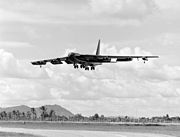
A B-52D approaching U-Tapao in October 1972.
The B-52s would fly on a mission in groups of three, and three B-52s could cut a swath miles long through the jungle, with the aircraft flying so high that the enemy had no idea they were under attack until the bombs began to hit. The shock of such concentrated high explosive was tremendous, with tales of scouts on the ground finding entire enemy units dead, without a mark on them, simply killed by concussion. Survivors of such attacks were demoralized or shellshocked. The bomber would also ultimately take on the jungle tunnel complexes that frustrated the Americans for so long, carpeting them with heavy bombs fitted with delayed action fuzes. The bombs would bury themselves deeply into the ground and then detonate, caving in the tunnels.
However, the B-52 itself could not really do much to change the course of the war, since the Johnson Administration, hobbled by fears of a "wider war", failed to devise any effective military and political strategy to deal with the insurgency in Vietnam. The B-52 was devastating when targets could be found, but in many cases the enemy was elusive and all the bombers accomplished was to level stretches of jungle and kill lots of monkeys.
It has been debated ever since whether there was any rational way to win the conflict. Optimists claim the often absurd "rules of engagement" for attacks on the enemy, imposed from the top by US president Lyndon Johnson and his defense secretary Robert McNamara, crippled the ability of US forces to fight. The Johnson Administration tried to fine-tune the war, selectively increasing the pressure to try to force the North Vietnamese to negotiate, while avoiding any major escalation.
Known SAC units at U-Tapao[]
U-Tapao was initially more of a forward field than it was a main operating base, with responsibility for scheduling missions still remaining at Andersen AFB. Small numbers of aircraft were drawn from each SAC B-52D unit to support the effort in Thailand. Known squadrons which deployed B-52 and KC-135 aircraft and crews to U-Tapao were:
- 9th Bombardment Squadron, 7th Bombardment Wing (Heavy), Carswell AFB, Texas
- 2nd Bombardment Squadron, 22nd Bombardment Wing (Heavy), March AFB, California
- 77th Bombardment Squadron, 28th Bombardment Wing (Heavy), Ellsworth AFB, South Dakota
- 6th Bombardment Squadron, 70th Bombardment Wing (Heavy), Clinton-Sherman AFB, Oklahoma
- 322nd Bombardment Squadron, 91st Bombardment Wing (Heavy), Glasgow AFB, Montana
- 325th Bombardment Squadron, 92nd Bombardment Wing (Heavy), Fairchild AFB, Washington
- 328th & 329th Bombardment Squadrons, 93rd Bombardment Wing (Heavy), Castle AFB, California
- 337th Bombardment Squadron, 96th Strategic Aerospace Wing, Dyess AFB, Texas
- 346th & 348th Bombardment Squadrons, 99th Bombardment Wing, Westover AFB, Massachusetts
- 367th Bombardment Squadron, 306th Bombardment Wing (Heavy), McCoy AFB, Florida
- 486th Bombardment Squadron 1966–1970, 22d Bombardment Wing (Heavy), March AFB, California
- 528th Bombardment Squadron 1969, 380th Strategic Aerospace Wing (Heavy), Plattsburgh AFB, New York
- 736th Bombardment Squadron, 454th Bombardment Wing (Heavy), Columbus AFB, Mississippi
- 764th Bombardment Squadron, 461st Bombardment Wing, Amarillo AFB, Texas
- 393rd Bombardment Squadron, 509th Bombardment Wing (Heavy), Pease AFB, New Hampshire
- 920th Air Refueling Squadron, 379th Bombardment Wing, Wurtsmith AFB, Michigan
These units deployed usually on 90 days tours.
Sapper attack[]
On 10 January 1972, enemy insurgents attempted to destroy B-52 aircraft via a 'Sapper Attack' wherin 'satchel charges' were placed in or near aircraft. The estimate of attackers varies from 3 to 10 individuals, with off base fire support. Gunfire was exchanged and a number of explosions occurred. This is the only officially reported attack against U-Tapao, although eyewitness reports reflect a number of mortar attacks and numerous incidents of sabotage.[citation needed]
Khe Sanh[]
One of the most important actions of the B-52 in the Vietnam War was during the siege of Khe Sanh in early 1968. The North Vietnamese surrounded an isolated US Marine outpost there and began conducting a methodical siege, building trenchworks that crept closer to the outpost while the two sides traded fire.
Concentrated bombardments by B-52s with unbroken waves of six aircraft, attacking every three hours, dropped bombs as close as 900 feet (270 m) from the perimeter of the outpost, cratered out the North Vietnamese entrenchments and inflicted heavy casualties, forcing them to give up the siege. 2,548 B-52 sorties were flown under the appropriately-named OPERATION NIAGARA in support of the defense of Khe Sanh, dropping a total of 54,129 tonnes (59,542 tons) of bombs.
Raids were not only flown out of Andersen AFB and U Tapao, but from Kadena Air Base on Okinawa, where B-52Ds had been sent to counter aggressive North Korean moves. The fact that Kadena was performing raids on Southeast Asia was kept secret to keep from inflaming Japanese public opinion. The Japanese had been on the receiving end of American heavy bomber strikes only a few decades before, and it took no great wisdom to realize they would find even passive involvement in such activities very disagreeable.
While the bombers were formally restricted from dropping their bombs any closer than a kilometer from the Khe Sanh base perimeter, the Marines lied to the aircrews and sometimes put them at 500 metres (1,600 ft) or even closer. When the enemy finally withdrew, Americans scouting out the abandoned North Vietnamese positions found a moonscape of craters with no trees standing, littered with hundreds of enemy dead.
Raids in Cambodia[]
Beginning in March 1969, B-52s were performing raids not only on South Vietnam and Laos, but on Cambodia as well. The Nixon Administration had approved this expansion of the war not long after entering office in the spring of 1969. These Cambodian bombing raids were initially kept secret, and both SAC and Defense Department records were falsified to report that the targets were actually in South Vietnam.
The Cambodian raids were actually carried out at night under the direction of ground units using the MSQ-77 radar, which guided the bombers to the release point and told them the precise moment to release their bombs. This made the deception easier, since even the crew members aboard the bombers did not have to know what country they were bombing. However, the specific flight coordinates (longitude and latitude) of the points of bomb release were noted in the navigator's logs at the end of each mission, and a simple check of the map could tell the crews which country they were bombing.
The Cambodian effort would eventually turn out to be something of a fiasco. It is unclear how much damage was done to North Vietnamese Army in their enclaves there, but it is perfectly clear that the raids did much to destabilize the Cambodian government, eventually leading to the downfall of the Norodom Sihanouk government and the rise of the notoriously savage Khmer Rouge regime.
Raids in North Vietnam[]
U-Tapao based B-52s carried out Operation Arc Light attacks on North Vietnam, although at first only the very southernmost part near the Demilitarized Zone was hit. The B-52s generally avoided North Vietnamese airspace at this stage in the war, lest one of them fall victim to a Surface-to-air missile (SAM), which would have been a propaganda coup for North Vietnam and extremely embarrassing to the Defense Department.
307th Strategic Wing[]
On 21 January 1970, the 4258th SW was redesignated as the 307th Strategic Wing. The 307th was the only regular Air Force SAC Wing stationed in Southeast Asia. The 307th was under the command and control of Eighth Air Force, based at Andersen AFB, Guam.
Four provisional squadrons were organized under the 307th:
- Bombardment Squadron (Provisional), 364, 1973–1975
- Bombardment Squadron (Provisional), 365, 1973–1974. Disbanded 7/17/74
- Bombardment Squadron (Provisional),486, 1970–1971
- Air Refueling Squadron (Provisional), 901, 1974–1975
In addition, two four-digit bomb squadrons (4180th, 4181st) were assigned, but were not operational.
Operation Linebacker[]
The Vietnamization of the Vietnam war was put to the test in the spring of 1972, when the North Vietnamese launched a full-scale offensive across the Vietnamese Demilitarized Zone (DMZ), supported by tanks and heavy artillery. By this time, the US was no longer in the forefront of the ground war, with South Vietnamese units taking the lead. However, America was still providing air power, and US combat planes flew vast numbers of strikes, smashing the North Vietnamese. Although there had been no campaign of strikes into North Vietnam since the end of ROLLING THUNDER, the Nixon Administration ordered a new air offensive, initially codenamed FREEDOM TRAIN and then becoming LINEBACKER, with relatively few restrictions on targets that could be hit.
The B-52s conducted a limited number of strikes against North Vietnam as part of the spring 1972 invasion, though most of their sorties were on Arc Light missions elsewhere. The North Vietnamese offensive was crushed, but the strikes on North Vietnam continued, only winding down in October, ahead of the United States presidential election, 1972. Richard Nixon was reelected, and the attacks quickly ramped up again in November.
In late 1972, the B-52 was confronted with surface to air missile (SAM) defenses, it was only a matter of time before the North Vietnamese got lucky. That finally happened on 22 November 1972, when a B-52D was damaged by an SA-2 SAM in a raid on Vinh, an important rail center in the southern part of North Vietnam. The bomber's pilot managed to get the burning aircraft back to Thailand before the crew bailed out, leaving the aircraft to crash. All the crew were recovered safely.
Operation Linebacker II[]
Since 1967, the Americans had been negotiating with North Vietnam to allow the US to withdraw from Vietnam in peace, and get back prisoners of war (POWs) rotting in North Vietnamese POW camps. The negotiations had been a frustrating, quarrelsome joke for years, and in late 1972 the Nixon Administration finally ran out of patience and ordered an all-out air offensive against North Vietnam.
The bombing raids began on 18 December 1972. The new campaign, codenamed LINEBACKER II, involved very heavy attacks by almost every strike aircraft the US had in the theater, with the B-52 playing a prominent role. The initial plan scheduled attacks for three days. Along with heavy strikes by Air Force and Navy tactical aircraft, 129 B-52s in 3 waves (approx 4 hours apart) from the 307th Strategic Wing at U-Tapao RTNAF, Thailand and B-52Ds and −52Gs of both wings based at Andersen AFB, Guam, the 43d Strategic Wing and the 72 Strategic Wing (Provisional). These went into battle on the night of 18 December, with the crews under strict orders to fly straight and level on approach and not release bombs unless they were sure they were on the target. The brass didn't want reports showing up in the news media that they had bombed a hospital by mistake.
The B-52s were assisted by F-4 Phantoms laying down corridors of chaff and providing Barrier Combat air patrol (BARCAP) against North Vietnamese MiG-17s; Lockheed EC-121 College Eye radar aircraft tracking the comings and goings of enemy fighters; F-105 Thunderchiefs performing "Wild Weasel" attacks on surface to air missile (SAM) sites; and EB-66 Destroyer jamming aircraft blinding enemy radars and communications.
Three B-52s were lost on the 18th. 93 flew raids on the 19th, with no losses, but the strike plan was basically the same as it had been the day before. Though radar jamming denied SAM crews targeting data, North Vietnamese noticed the pattern. 99 B-52s flew strikes on 20 December, and SAM sites fired their missiles in a "shotgun pattern. Six aircraft were blown out of the sky.
B-52 crews grew increasingly frustrated with the predictable tactics, knowing they would lead to trouble sooner rather than later, and the result of the losses was an outburst of protest and anger. The crews were perfectly willing to fly combat missions, but they were not happy about dead-headed military bureaucracy setting them up like ducks in a shooting gallery. The Air Force has never been very specific on what exactly happened, some sources claiming that they had a near-mutiny on their hands, but it is clear that the brass decided to sit down and work on getting their house in order.
The Andersen AFB based B-52G were taking a disproportionate share of the losses. The "wet wing" of the B-52G made it more vulnerable to battle damage, as did the fact that not all of the B-52Gs had the same level of countermeasures fit as the B-52D. This situation was made all the more ironic because the B-52G, with no capability of carrying bombs on its external pylons, could only carry about a quarter the conventional bombload of the B-52D. The B-52G could carry 1 rack with 27 MK-82 500 pound bombs, where the B-52D could carry 3 racks for a total of 84 500-lb Mk 82 or 42 750 lb M117 conventional bombs internal and 24 external bombs made for a total of 108 bombs. All Andersen Linebacker II missions required at least 1 (and some missions required 2) aerial refuelings, supported by the 376th Strategic Wing based at Kadena AB.
The B-52Gs were ordered to stand down for two days while fixes were hurriedly implemented. 30 B-52Ds out of U Tapao flew strikes on 21 December, but the results were still bad, with two bombers lost. The next night, the 22nd, 30 B-52Ds came back again, but this time their attacks were performed from unpredictable directions, and there were no losses. Strikes were made on SAM sites to help wear down the defenses for later.
The same approach, 30 bombers using unpredictable tactics, was repeated on the 23rd and 24th, once again with no losses. The raids were called off on Christmas Day as a good-will gesture, to which there was no response. The Air Force hadn't been expecting any different, and had spent all of Christmas Day setting up an operation that would take advantage of all the lessons that had been learned in the campaign.
On 26 December, a total of 120 B-52s performed raids, with 113 reaching their targets nearly simultaneously, all dropping their bombs within a space of 15 minutes, overwhelming the defenses. Two B-52s were lost, but the North Vietnamese were beginning to run out of SAMs and their air defenses were wobbly. 60 B-52s came back on the 27th, with two lost, but this was the last gasp of the defenders. 60 bombers hit again on the 28th and 29th, with no losses. The North Vietnamese agreed to negotiate on 29 December, and the B-52s stopped their strikes against North Vietnam.
In 11 days of concentrated bombing, B-52s had performed 729 sorties and dropped 13,640 tonnes (15,000 tons) of bombs. The North Vietnamese claimed that almost 1,400 civilians were killed, though the fact that there weren't more was a testimony to the accuracy of the strikes, given the staggering amount of explosives dropped.
The campaign was expensive, and not merely in financial terms. 15 B-52s were lost, with 33 of their aircrew killed or missing in action. While the Air Force justifiably regarded the B-52 losses as severe, in one minor compensation, North Vietnamese SAMs had hardly proven effective, with a kill ratio of only 2% to 3% of the number of SAMs fired. They had scored the kills by simply flooding the sky with SAMs, and the Soviet Union was not happy about the poor showing of their weapons. In another small compensation, North Vietnamese MiG interceptors proved completely ineffective at taking on the B-52s according to US statistics, the MiGs scored no kills and two of them were claimed shot down by the "quad-fifties" in B-52 tail turrets. However, North Vietnamese records insist that two of the Buffs shot down were MiG kills. Although the unrestricted bombing campaign was referred to by critics as "an attempt to pillage and burn the enemy to the conference table", LINEBACKER II, sometimes called the "Eleven-Day War", was believed by many as devastatingly successful in achieving its goals. Henry Kissinger contrasted the extremely uncooperative attitude of North Vietnamese negotiators before the raids with the great willingness to talk after them, and concluded: "These facts have to be analyzed by each person for himself." It is tempting to speculate that such a ruthless air campaign earlier in the war might have changed its course considerably, but history is not a controlled experiment and speculation is all that it is. Howerer, the North Vietnamese account's was that the operation did not achieved it supposed goals. Vo Nguyen Giap's claim that the US had boycotted the negotiation process, and Operation Linebacker II was an attempt to force the Vietnamese into accepting their own "peace solution". He's also attributed the small amount of civilian deaths, not to the bombing's accuracy, but the fact that Hanoi was almost emptied. In the end, the Paris Peace Accord was signed with terms favorable to them, and it takes Nixon to force Thieu, president of South Vietnam into signing it with threat of a possible coup against him.
A cease-fire was signed on 23 January 1973, with American POWs being flown out of Hanoi beginning on 18 March. However, the B-52's war was not quite over, with Arc Light strikes on Laos continuing into April and on Cambodia into August. The 307th SW ended all combat operations on 14 August 1973.
1975 South Vietnamese collapse[]
.
Two VNAF C-130As, most likely belonging to the 433rd Transport Squadron (the 435th had tailcodes in the Hxx range) on the tarmac at Royal Thai Navy Airfield – April 1975
In the two years following the 1973 Paris Peace Accords and the War Powers Act the North Vietnamese army underwent a massive rebuilding to recoup the losses suffered during the failed 1972 Easter Offensive. By the spring of 1975, the North Vietnamese Army had grown to be the fifth largest in the world, and in late December 1974 had begun their drive towards Saigon. By the end of March 1975, North Vietnamese troops had taken over several key cities, either because the ARVN forces were unequipped and undermanned, or because they had fled from the approaching enemy.
By the second week of April, the situation had deteriorated to the point that most of South Vietnam was under the control of the North Vietnamese Army. A Congressional delegation had visited South Vietnam and was unable to convince President Ford to provide more aid. President Ford stated in a speech on 23 April that the Vietnam War ".. was finished".
An estimated 8,000 U.S. and third-country nationals needed to be evacuated from Saigon and the shrinking government-controlled region of South Vietnam, along with thousands of Vietnamese who had worked for the United States during the war who would be in dire straits under the Communists. The evacuation of Saigon was originally code-named Talon Vice and called for the evacuation of personnel via commercial aircraft from Tan Son Nhut Airport and other locations. The plan called for the ARVN to provide crowd control and to secure the evacuation areas. However as the situation deteriorated rapidly in South Vietnam, the plan was changed to use rooftops as helicopter landing pads for evacuating personnel.
The evacuation plans were completed by 18 April and the name was changed to Operation Frequent Wind. U-Tapao Airfield was used as a jumping-off point by the USAF with eight CH-53 and two HH-53 "Sea Stallion" helicopters. Additional helicopters were standing by on board the USS Midway, and at the Nakhon Phanom and Ubon air bases. Korat placed a force of F-4's, A-7's and AC-130's on alert. Udon discontinued its training flights and put its F-4 fighters on alert for combat missions over South Vietnam to support the evacuation.
On 25 April South Vietnamese president Thieu fled the country, and the final collapse of the South Vietnamese government was imminent. Aircraft started to arrive at U-Tapao in South Vietnamese markings. They arrived all that day and the next several days. C-119's, C-130's, C-47's were filled to capacity with men, women and children. After their arrival, the Vietnamese were sequestered in tents near the runway. The adjacent parking ramps and grassy areas were being filled to capacity with South Vietnamese helicopters and aircraft, including many F-5E/F aircraft which were just delivered to South Vietnam in the previous few months.
By 29 April the North Vietnamese had brought in Anti-Aircraft Artillery (AAA) and mobile Surface-To-Air Missiles (SAM) to the Saigon area. Mortar and artillery rounds were impacting at Tan Son Nhut Air Base severely disrupting the evacuation activities. At the US Embassy, Saigon, Marine guards shut off the electricity to the elevators and exploded tear gas canisters as they went to the roof to join the evacuees. The last helicopter left the embassy at 7:53 am On 29 April, Douglas VC-47A 084 of Air America crashed on landing. The aircraft was on a flight from Tan Son Nhat International Airport, Saigon, Vietnam.[8]
On 30 April South Vietnam surrendered. A handful of South Vietnamese Air Force aircraft that had been performing last-ditch air strikes completed their missions and flew on to U-Tapao. On 2 May the last air rescue helicopters returned to Nakhon Phanom. The war in Vietnam was over.
Mayagüez incident[]
On 12 May 1975, less than two weeks after the fall of Saigon, a unit of the Cambodian Khmer Rouge navy seized the American-flagged container ship SS Mayaguez, taking the crew hostage. U-Tapao Airfield served as a staging point for United States Marines which deployed to U Tapao and assaulted Koh Tang Island aboard Air Force CH-53s of the 21st Special Operations Squadron and HH-53s of the 40th Aerospace Rescue and Recovery Squadron, hitting the beach at sunrise on the 15 May in the Air Force’s first-ever helicopter-assault operation.
However, virtually everything that could go wrong did. The Marines and helicopter crews never received the good intelligence available about the island’s defenders; they went in expecting 18 to 40 lightly armed militia but instead found a reinforced battalion of elite Khmer Rouge naval infantry. The Cambodians shot down three of the first four CH-53 helicopters to approach the island, one of them carrying the Marine forward air controller (FAC) team; the fourth was badly damaged and forced to abort. For hours, Air Force A-7's from Korat RTAFB provided fire support failed to find the marines, let alone support them. The Marines hung on by a thread while the remaining helicopters of the assault wave fed in reinforcements; the enemy badly shot up most of the remaining seven helicopters – only three landed in commission at U Tapao. A boarding party, transferred to the USS Harold E. Holt (FF-1074) by helicopter, seized the Mayaguez, only to find the ship deserted; the Cambodians had taken its crew to the mainland two days earlier.
When the extraction began, only five helicopters were available, and one was quickly shot up and put out of commission. Maintenance provided one more as the rescue proceeded, providing a razor-thin margin of success.
USAF withdrawal[]
U-Tapao had come a long way since the first American personnel arrived in the mid-1960s. With the fall of both Cambodia and South Vietnam in the spring of 1975, the political climate between Washington and Bangkok had become very sour, and the Royal Thai Government wanted the USAF out of Thailand by the end of the year. In response, the USAF implemented Palace Lightning which was the plan by which the USAF would withdraw its aircraft and personnel from Thailand.
The SAC units left in December 1975; however, the base remained under American control until it formally handed to the Thai government on 13 June 1976.
USAF major units at U-Tapao[]
- 4258th Strategic Wing (1966–1970)
- 307th Strategic Wing (1970–1975)
- Young Tiger Tanker Force (1966–1975)
- Strategic Wing (Provisional), 310 (1972)
- Consolidated Aircraft Maintenance Wing (Provisiona), 340 (1972)
- 99th Strategic Reconnaissance Squadron (1972–1976)
- Air Division (Provisional), 310th (1972)
- 11th USAF Hospital
- 635th Combat Support Group
- 1985th Communications Squadron
- 554 CES (Red Horse - Combat Engineers)
U-Tapao USAF unit emblem gallery[]
See also[]
- United States Air Force in Thailand
- United States Pacific Air Forces
- Strategic Air Command
- Eighth Air Force
References[]
- ↑ Airport information for VTBU at World Aero Data. Data current as of October 2006.Source: DAFIF.
- ↑ Airport information for UTP at Great Circle Mapper. Source: DAFIF (effective Oct. 2006).
- ↑ EXCLUSIVE: Sources Tell ABC News Top Al Qaeda Figures Held in Secret CIA Prisons – ABC News
- ↑ [Clarification needed](Thai) ต้นโพธิ์ทรงปลูกรอดพายุ พระเทพฯ ทรงห่วงพม่า, Thai Rath, 9 May 2008
- ↑ JTF Caring Response News Story
- ↑ USAID Burma: Cyclone Nargis
- ↑ NASA Weather Project
- ↑ "084 Accident description". Aviation Safety Network. http://aviation-safety.net/database/record.php?id=19750429-0. Retrieved 21 August 2010.
This article incorporates public domain material from the Air Force Historical Research Agency website http://www.afhra.af.mil/.
- Endicott, Judy G. (1999) Active Air Force wings as of 1 October 1995; USAF active flying, space, and missile squadrons as of 1 October 1995. Maxwell AFB, Alabama: Office of Air Force History. CD-ROM.
- Glasser, Jeffrey D. (1998). The Secret Vietnam War: The United States Air Force in Thailand, 1961–1975. McFarland & Company. ISBN 0-7864-0084-6.
- Martin, Patrick (1994). Tail Code: The Complete History of USAF Tactical Aircraft Tail Code Markings. Schiffer Military Aviation History. ISBN 0-88740-513-4.
- Ravenstein, Charles A. (1984). Air Force Combat Wings Lineage and Honors Histories 1947–1977. Maxwell AFB, Alabama: Office of Air Force History. ISBN 0-912799-12-9.
- USAAS-USAAC-USAAF-USAF Aircraft Serial Numbers—1908 to present
- The Royal Thai Air Force (English Pages)
- Royal Thai Air Force – Overview
External links[]
| Wikimedia Commons has media related to U-Tapao Royal Thai Navy Airfield. |
- Utapao Royal Thai Airbase mid-summer 1971 unit history
- U-Tapao Royal Thai Navy Airfield history
- 635 Supply Chain Operations Wing fact sheet — successor to 635 Combat Support Group
- U-Tapao – history, photos, maps, etc.
- YouTube.com – video – U-Tapao 1969
- YouTube.com – video – U-Tapao Buff Launch – (early 1970s)
- The short film STAFF FILM REPORT 66-17A (1966) is available for free download at the Internet Archive [more]
| ||||||||||
| ||||||||||||||||||||||||||||
The original article can be found at U-Tapao Royal Thai Navy Airfield and the edit history here.

